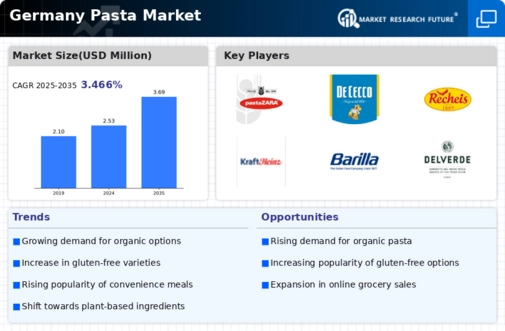The Germany Pasta Market features a vibrant, competitive landscape characterized by a blend of local and international brands vying for consumer attention. The market is experiencing steady growth driven by rising demand for convenience foods, increasing consumer awareness of health and nutrition, and the versatile nature of pasta as a staple food.
Within this framework, companies are not only competing based on product quality and variety but are also focusing on innovative marketing strategies, packaging, and sustainable sourcing practices. The competitive dynamics include both traditional pasta products as well as gluten-free and organic options appealing to a diverse range of consumer preferences.
The growing trend towards plant-based diets, convenience meals, and premium pasta products also creates opportunities for firms to differentiate themselves in a crowded market.
Pasta Zara has established a commendable presence in the Germany Pasta Market, known for its commitment to quality and authenticity. The company emphasizes the traditional Italian recipes in its pasta production, which resonates with consumers looking for genuine culinary experiences.
Pasta Zara’s strengths lie in its robust supply chain and its ability to offer a consistent and diverse product lineup, including various shapes and sizes of pasta that cater to different culinary needs. Through effective distribution channels and a reputation for high-quality products, Pasta Zara has been able to enhance its visibility and market share in Germany.
Additionally, Pasta Zara’s strategic partnerships and collaborations with local retailers enhance its reach, ensuring that it remains competitive in a fast-evolving market. De Cecco has carved a significant niche in the Germany Pasta Market by offering a premium range of pasta products known for their superior texture and cooking quality.
The company focuses on high-quality durum wheat and adheres to traditional manufacturing processes that enhance the taste and quality of its pasta. De Cecco's strengths include a strong brand reputation, a loyal customer base, and innovative marketing strategies that reinforce its positioning as a premium pasta choice. The company's product portfolio includes various forms of pasta, such as spaghetti, penne, and fettuccine, often promoted for their culinary versatility.
De Cecco's strategic presence in Germany is further bolstered by its efficient distribution networks and selective partnerships with local distributors. Additionally, the company may engage in collaborations or acquisitions to expand its market footprint, enabling it to respond effectively to consumer trends and preferences within the German market.













